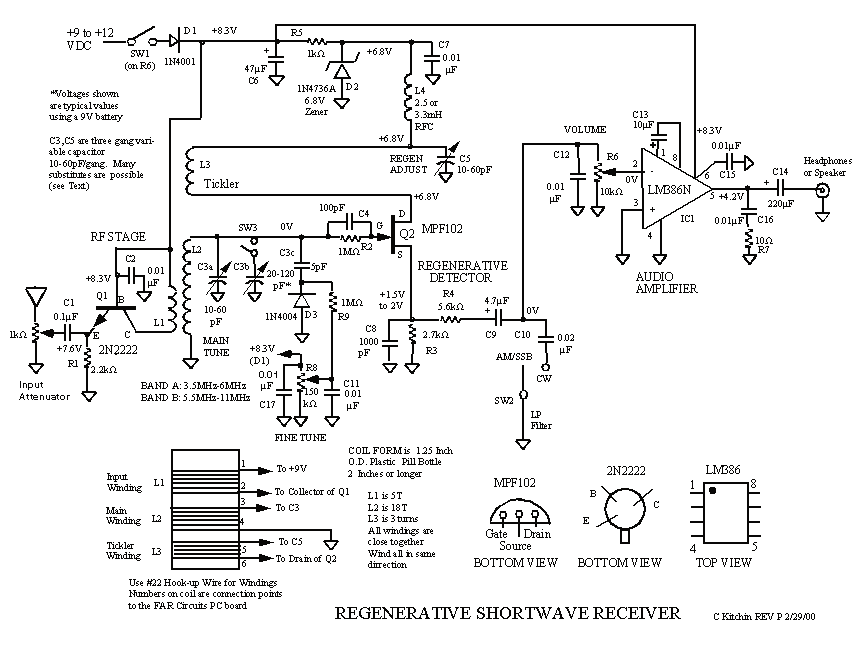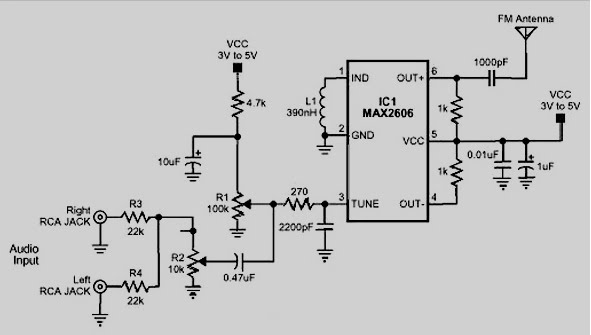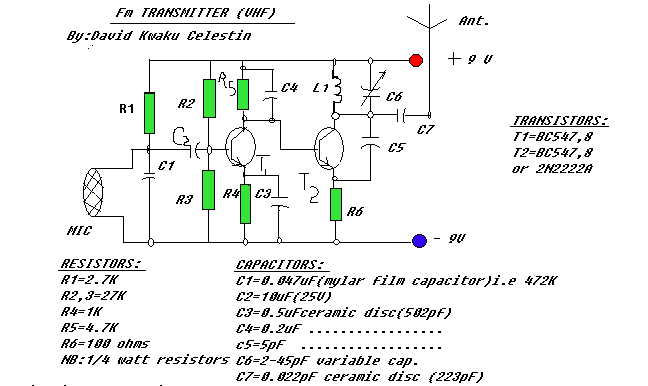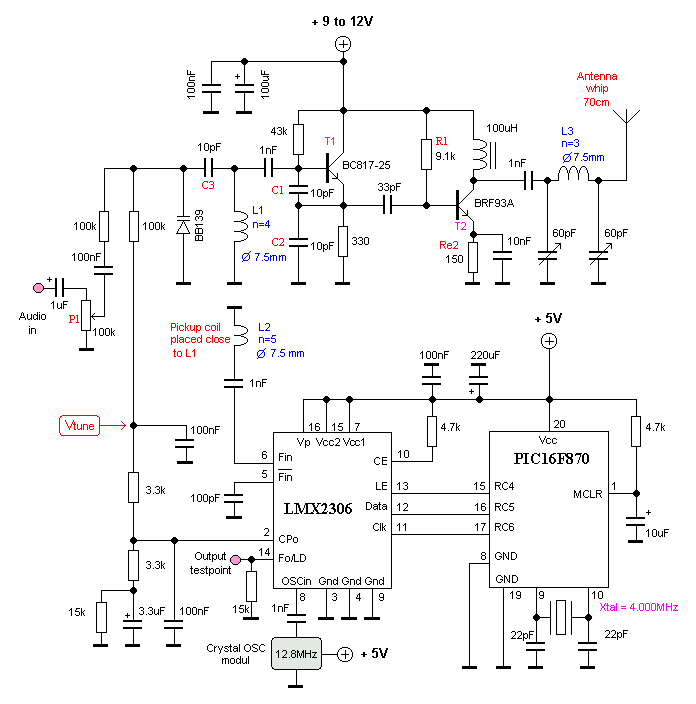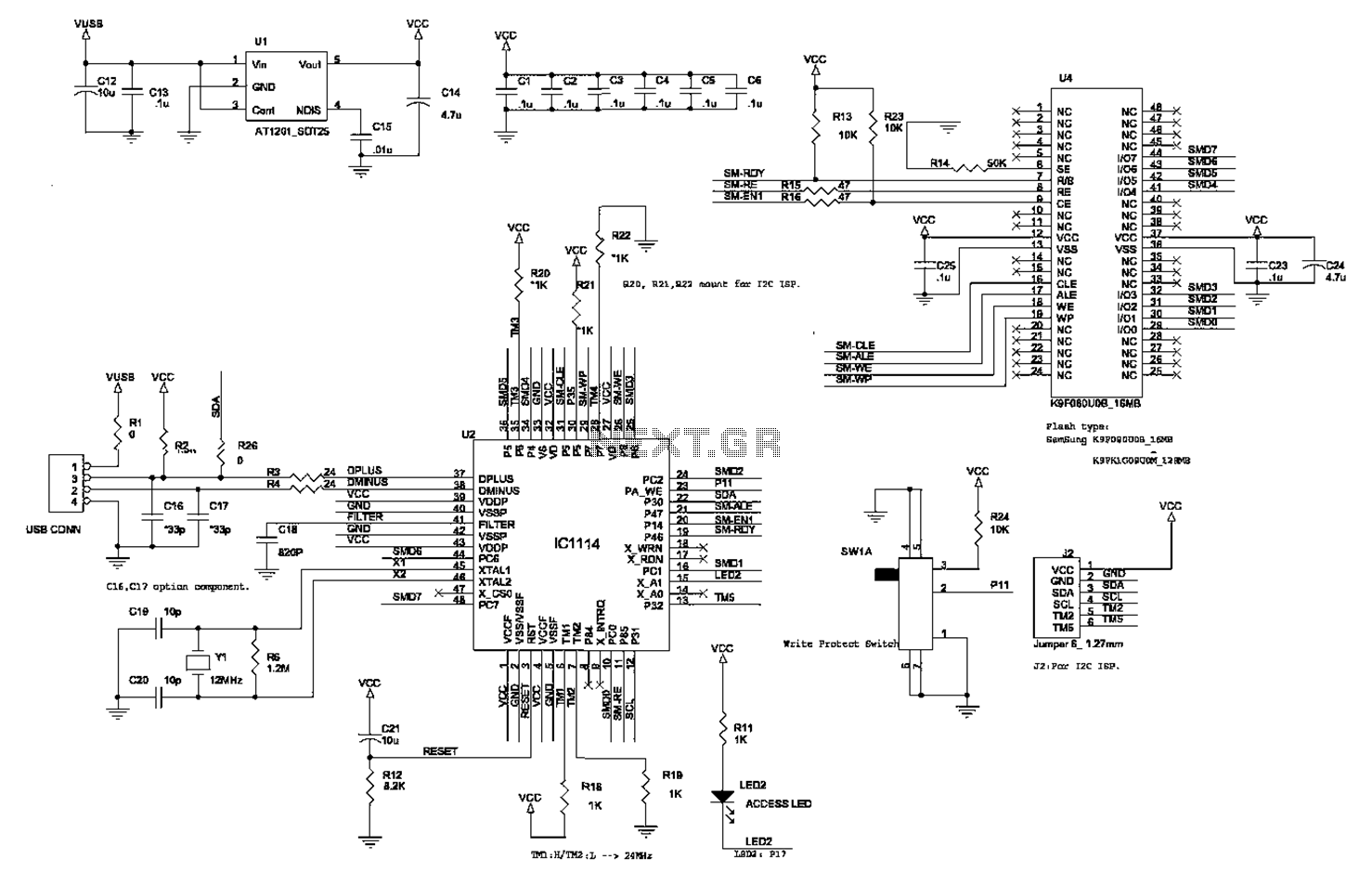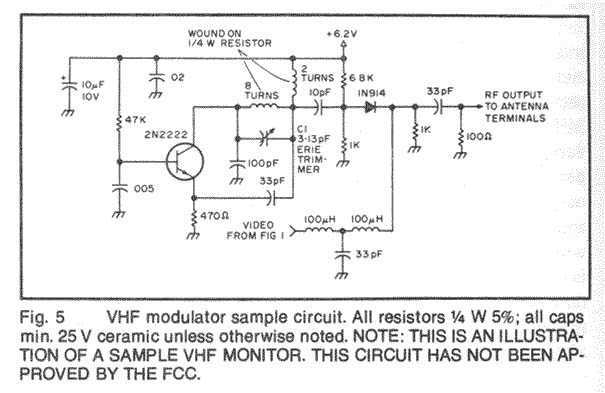
3v fm transmitter for short distance
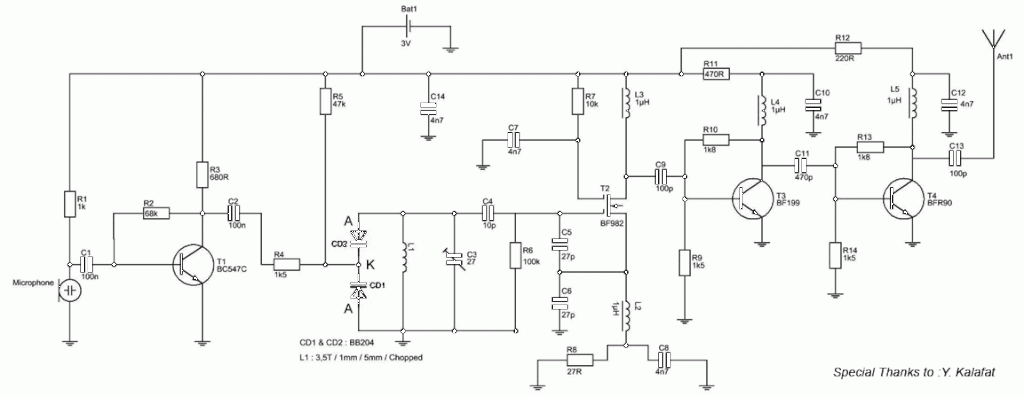
The core component of the circuit is a Colpitts type oscillator. The capacitors C3, C4, C5, C6, diodes CD1-CD2, and inductor L1 determine the oscillation frequency. The active components in the oscillator include the BF982 and a dual-gate MOSFET. When the input impedance of the MOSFET gate inputs is high, the LC tank circuit remains unaffected. However, the transistors influence the LC tank, inducing a phase shift. Two driver stages are incorporated to isolate the antenna from the oscillator. The first stage, utilizing a BF199 transistor, amplifies the low output signal of the oscillator and functions as a constant load. The second stage, employing a BFR90 transistor, further amplifies the signal transmitted through the antenna. A short copper wire can serve as the antenna in this configuration. Connecting a larger antenna is unnecessary due to the low output power of the circuit.
The Colpitts oscillator is a type of electronic oscillator that utilizes a combination of capacitors and an inductor to produce oscillations at a specific frequency. In this circuit, the capacitors C3, C4, C5, and C6, along with the inductor L1, are critical components that set the resonant frequency of the oscillator. The BF982 transistor, known for its low noise and high-frequency characteristics, works in conjunction with the dual-gate MOSFET to ensure stable oscillation. The high input impedance of the MOSFET gates allows the LC tank circuit to operate without significant loading effects, maintaining the integrity of the oscillation.
The introduction of the driver stages serves a dual purpose: it enhances signal strength and provides isolation between the oscillator and the antenna. The first driver stage, implemented with the BF199 transistor, amplifies the oscillator's output while acting as a constant load, ensuring that the oscillator operates within its optimal parameters. The second driver stage, utilizing the BFR90 transistor, further boosts the signal before transmission through the antenna, ensuring adequate strength for effective radiation.
The choice of a short copper wire as an antenna is suitable for this circuit, given the low output power. The design does not necessitate a larger antenna, which could introduce additional loading and potentially affect the performance of the oscillator. This configuration leverages the compact and efficient design of the Colpitts oscillator while ensuring reliable signal amplification and transmission. Overall, this circuit design exemplifies effective use of components to achieve desired electronic oscillation and signal amplification.The important part of the circuit is formed of the Colpitts type oscillator. C3, C4, C5, C6, CD1-CD2 and L1 determines the frequency. BF982 and dual gate MOSFET are active parts in the oscillator. When the input impedance of the MOSFET gate inputs are high, LC tank is not affected. However transistors force the LC tank and cause phase shift. Two drive r stages are added to isolate the antenna from oscillator. First stage (BF199) amplifies the low signal of the oscillator and works as a constant load. The second stage (BFR90) amplifies the signal going through the antenna some more. A short copper wire can be used as an antenna here. Attaching a large antenna to this circuit is unnecessary because the output power is low. The important part of the circuit is formed of the Colpitts type oscillator. C3, C4, C5, C6, CD1-CD2 and L1 determines the frequency. BF982 and dual gate MOSFET are active parts in the oscillator. When the input impedance of the MOSFET gate inputs are high, LC tank is not affected. However transistors force the LC tank and cause phase shift. Two driver stages are added to isolate the antenna from oscillator. First stage (BF199) amplifies the low signal of the oscillator and works as a constant load. The second stage (BFR90) amplifies the signal going through the antenna some more. A short copper wire can be used as an antenna here. Attaching a large antenna to this circuit is unnecessary because the output power is low. 🔗 External reference
The Colpitts oscillator is a type of electronic oscillator that utilizes a combination of capacitors and an inductor to produce oscillations at a specific frequency. In this circuit, the capacitors C3, C4, C5, and C6, along with the inductor L1, are critical components that set the resonant frequency of the oscillator. The BF982 transistor, known for its low noise and high-frequency characteristics, works in conjunction with the dual-gate MOSFET to ensure stable oscillation. The high input impedance of the MOSFET gates allows the LC tank circuit to operate without significant loading effects, maintaining the integrity of the oscillation.
The introduction of the driver stages serves a dual purpose: it enhances signal strength and provides isolation between the oscillator and the antenna. The first driver stage, implemented with the BF199 transistor, amplifies the oscillator's output while acting as a constant load, ensuring that the oscillator operates within its optimal parameters. The second driver stage, utilizing the BFR90 transistor, further boosts the signal before transmission through the antenna, ensuring adequate strength for effective radiation.
The choice of a short copper wire as an antenna is suitable for this circuit, given the low output power. The design does not necessitate a larger antenna, which could introduce additional loading and potentially affect the performance of the oscillator. This configuration leverages the compact and efficient design of the Colpitts oscillator while ensuring reliable signal amplification and transmission. Overall, this circuit design exemplifies effective use of components to achieve desired electronic oscillation and signal amplification.The important part of the circuit is formed of the Colpitts type oscillator. C3, C4, C5, C6, CD1-CD2 and L1 determines the frequency. BF982 and dual gate MOSFET are active parts in the oscillator. When the input impedance of the MOSFET gate inputs are high, LC tank is not affected. However transistors force the LC tank and cause phase shift. Two drive r stages are added to isolate the antenna from oscillator. First stage (BF199) amplifies the low signal of the oscillator and works as a constant load. The second stage (BFR90) amplifies the signal going through the antenna some more. A short copper wire can be used as an antenna here. Attaching a large antenna to this circuit is unnecessary because the output power is low. The important part of the circuit is formed of the Colpitts type oscillator. C3, C4, C5, C6, CD1-CD2 and L1 determines the frequency. BF982 and dual gate MOSFET are active parts in the oscillator. When the input impedance of the MOSFET gate inputs are high, LC tank is not affected. However transistors force the LC tank and cause phase shift. Two driver stages are added to isolate the antenna from oscillator. First stage (BF199) amplifies the low signal of the oscillator and works as a constant load. The second stage (BFR90) amplifies the signal going through the antenna some more. A short copper wire can be used as an antenna here. Attaching a large antenna to this circuit is unnecessary because the output power is low. 🔗 External reference
Warning: include(partials/cookie-banner.php): Failed to open stream: Permission denied in /var/www/html/nextgr/view-circuit.php on line 713
Warning: include(): Failed opening 'partials/cookie-banner.php' for inclusion (include_path='.:/usr/share/php') in /var/www/html/nextgr/view-circuit.php on line 713
